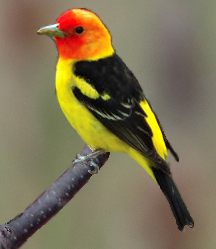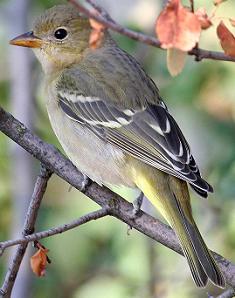Western Tanager 
Identification and Pictures
(Piranga ludoviciana)
Western tanagers are medium sized songbirds,
about 6 1/4 to 7 1/2 inches. The males stand out with
their striking colors. They are yellow with black wings,
and tail, and a red head. The wings have two white or
yellow wing bars. They have short, thick, pointed
bills, and the legs, and feet are gray. The red pigment of
the male is a result of his diet of insects and he will lose
most it in autumn. The females and juveniles are dull
greenish above, and olive-gray back, yellow below, with a whitish
belly, and white or yellow wing bars. Females are
sometimes mistaken for female orioles, which have thinner bills,
and longer tails. The tanager's flight is swift, and
direct with rapid beating wings.

Photo by Keith
Lee. The camera I use is the Canon
EOS 40D.
Sound
The Western tanager song is short phrases,
somewhat like the American robin. They also have a call
that sounds like pre-tee-tic, and chip. sound
sound 2
Preferred Habitat
They can be found in the western half of the
U.S. Their preferred habitat is open conifer, or mixed
forests. They migrate south to southern California,
Mexico, and into Central America for winter. They migrate at night, and travel at high altitudes.
Breeding and Nesting
During courtship the male will chase the
female through the trees. Western tanagers are monogamous. The female
builds a cup-shaped nest of twigs, grass, and bark lined with
hair, and rootlets on a tree branch. The female will
incubate 3 to 5 blue spotted eggs for about 13 days. Both parents feed, and
care for the young, which fledge in around 11 days. The
young birds will stay near the parents for about two more weeks.
Food
Their diets consist of insects, fruits, and berries.
They forage in trees and shrubs, also catching insects in the
air. They are often hard to see since they like to
forage high in the trees.
To learn about other favorite
birds click here.

|
